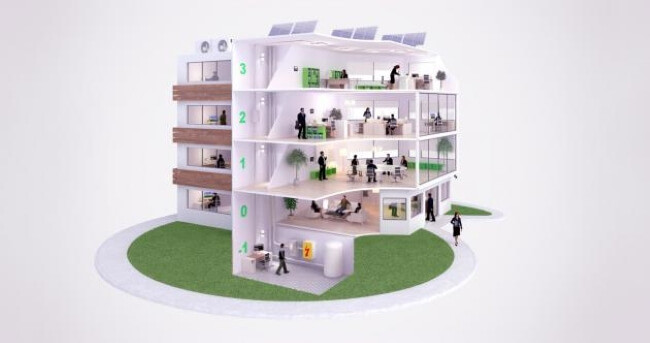Smart Wiring Technology an Essential Enabler for Smart Buildings
26-11-2019 | By Nnamdi Anyadike
Smart wiring, a system that enables the combination of many different types of wires into a single platform, is taking off both in the home and office. Modern buildings rely on a plethora of wiring with phone lines, TV and audio cables, computer and internet cables and connectors, security and home automation all jockeying for space. Dealing with the installation of each of these communications can be a complicated and costly process. But smart wiring allows for the integration of all these different systems and sensors. Key players in the smart home market include: Johnson Controls International, United Technologies Corporation, Schneider Electric, Honeywell International, Inc., Siemens AG, Amazon, Inc., Apple Inc., Google, ADT, Robert Bosch GmbH, and ABB Ltd.
Honeywell Unveils New Smart Wiring Devices
In July, Honeywell International Inc. the US producer of various consumer products, engineering and aerospace systems, announced a new range of smart wiring devices for the Indian market. The devices will be available in three series: ‘Harmony’, the most affordable series that fits into any wall surface; ‘Expression’, which is customisable and is available in a range of colours, patterns and textures; and ‘Prestige’ which is a premium offering. All the devices combine intelligent automation, advanced analytics and data visualisation. Anupam Mathur, Sales Director, New Business Connected Living Solutions, Honeywell Building Technologies, India said, “We are excited to announce the new range of smart wiring devices which are truly modular and retrofittable. The range has been designed to keep the ease of use and implementation in mind. They do not require any structural and electrical overhaul because of its modular design, and we are confident that the range will resonate well with the industry.”
Loxone Tree – a New Way to Wire the Smart Home
Earlier this year, Loxone Group, the developer of smart solutions, unveiled ‘Spots RGBW Tree’ its new low-voltage Loxone smart LED lighting. It provides directional warm light and utilises Loxone’s 4-wire Tree technology. ‘Loxone Tree’ smart wiring allows for up to 80% cable reduction and is simple to wire in and configure. The trunk of the Loxone Tree technology is the ‘Tree Extension’. Each Tree Extension has two branches and each branch can be used to connect up to fifty Tree devices. Commenting on the development, Loxone U.S. CEO Florian Woess said, “Loxone is establishing its strength in the fastest growing industry trend by equipping integrators with novelty fixtures. People are realizing the effects of true smart lighting and its increasing demand, as orders are already filling up to implement these Loxone lighting fixtures in smart home projects nationwide.”
Eplan Presents New Smart Wiring Solution
In October, Eplan Software & Service GmbH & Co. KG the developer of solutions for machine, plant and control cabinet construction presented Version 2.9 of its ‘Eplan Smart Wiring’, which is an update of its existing solution. It comes with a new user interface that flexibly depicts different workflows as well as with the integration of cables and hoses. “The architecture and layout of the Eplan Smart Wiring Monitor have been completely redesigned. The wiring status of projects is now displayed directly, including the test mode”, says the company. The wire feeder can operate the software via a touch screen and store the wiring progress directly in the system. Version 2.9 offers additional flexibility to its software users who can now customise their user interface individually to their needs. “In the United States, for example, wiring does not work classically with device identifiers but with numerical enumeration. That too can be adjusted individually. The new interface is ideal for individually depicting different workflows of customers. Information can be flexibly configured, displayed or hidden, so that the information that is crucial for the wire or project manager is in the foreground,” it continues.

Schneider Electric’s ‘Room of the Future’
Meanwhile, with its next-generation wireless and IP-based solutions, Schneider Electric is opting for wireless technology in the future-proofing of buildings and hotel infrastructure. In October, it announced the availability of its ‘Connected Room Solution’, a connectivity hub for efficiency and personalised occupant experiences. Schneider Electric's modular solution is an IoT ecosystem that consists of room control that can extend easily from HVAC to add lighting, blinds, and door locks, modern room sensors, an office occupant mobile application, and a host of new tools for simplified installation and commissioning. Built on an open platform, the Connected Room Solution will work with a variety of current and future protocols, devices, and applications. “Smart buildings and hotels are about more than just operational and energy efficiencies. Today, building and hotel owners must achieve those efficiencies while providing a better experience for their tenants, guests, and occupants,” said Manish Kumar, Senior Vice President, Digital Buildings Schneider Electric.
Outlook
The smart home market, including smart wiring, is expected to grow from $76.6 billion in 2018 to $151.4 billion by 2024, at a CAGR of 12.02%. Growth will be driven by factors, such as the internet and increased adoption of smart devices; home monitoring from remote locations; energy-saving and low carbon emission solutions; and the proliferation of smartphones and smart gadgets.

